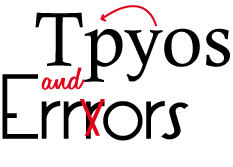 We’ve all been there: a press release, or organizational change announcement that we’ve seen a dozen times in the last 3 days. We’ve agonized over every quote, headline, job title and legal review and proofed it so many times that it’s practically tattooed on the inside of our eyelids.
We’ve all been there: a press release, or organizational change announcement that we’ve seen a dozen times in the last 3 days. We’ve agonized over every quote, headline, job title and legal review and proofed it so many times that it’s practically tattooed on the inside of our eyelids.
Sure that we’re delivering that high-quality product we know we can produce, we’ve hit the “send” button, only to see “it” in all its glory. “It” is the dreaded typo, the scourge of editorial excellence and the bane of the communicator’s existence. Just stitch a Scarlet “T” on our collective chest and get it over with, right?
With the ever-increasing pressure of time, and never-ending expectations of perfection, it’s getting harder by the day to deliver flawless editorial content; but things getting harder doesn’t equate to getting any sympathy.
And relying on spellcheck isn’t the only answer, a lesson I learned many years ago when auto-spellcheck changed the name of my then-CEO to “moron.” I can’t make this stuff up.
So how do we improve our odds of typo-free communications? I’ve pulled together a few techniques I, and my colleagues, have fine-tuned over the years. Like any set of solutions, each works better or worse depending on time, money and other resources. And you can use them in any combination. But if it saves you from just one typo, this list will have done some good for the world of the communicator.
Do it yourself – not. The easiest, simplest thing to do is proof it ourselves, right? Everyone else is too busy and we can’t ask them to drop everything to look at our draft. Wrong. Share the love and the pain by asking colleagues to take a few minutes to proof, and make yourself available to do the same for them. And they don’t have to be communications/PR/marketing
colleagues. My wife, the accountant, finds typos I swear weren’t there five minutes ago, and chuckles as she proofs anything having to do with numbers and percentages along the way.
Mix it up. Whether you do it yourself and/or give copy to others to proof, make a simple change and give different proof readers different sections to start proofing first. Research shows the best proofing is typically done in the first few paragraphs or pages of a longer document. So give half the proof readers the document in its normal sequence of pages; then give the others the back half of the document first, and the first half after that. You’ll be surprised at how much better the second-half proofing gets. And you’ll see who among your colleagues can’t tell the difference between the front and back of a document.
Proof on the edge. Take a sheet of white paper and put the top edge below the line of copy you’re reading, then move it down one line at a time. Many of us might have come across this technique at some time, but may have forgotten how helpful it is. It’s a great way to focus our eyes on one line at a time, and give us mental and visual relief from larger blocks of copy.
Get clearance. All too often, we hear about sensitive or confidential content that nobody but us can see. Sure, it makes us feel all-powerful and all-knowing, but it’s not much help with getting it right in the 11th hour. Check to see if others can sign confidentiality agreements early in the drafting process so they can review copy – especially final versions of documents – before they’re ready to be sent. You can even negotiate with legal and HR professionals to bring proofers in much later in the process to help mitigate the risk of breaking confidentiality.
Pay the tab. I know; spending money on proofing in these economically strapped times is about as popular an idea as an off-site in Tahiti. But it’s a lot less expensive and it really does help. When you’ve got planning time and you’ve found a good proofer who can be on call to do tight turn-around work, it’s worth every penny you spend. And there are plenty of good proofers out there. Now it’s important to remind you that good proofers aren’t necessarily good copy editors – that’s a different skill set that not all proofers have.
It goes without saying the spell check is a tool we should all use, but we cannot rely solely on it. It’s a good, quick step, but it can’t substitute for the human eye – at least not yet. While proofing is not the most glamorous part of communications and marketing, it’s one of the most fundamental skill sets that supports the flawless execution we all seek to delivre – er, deliver.


